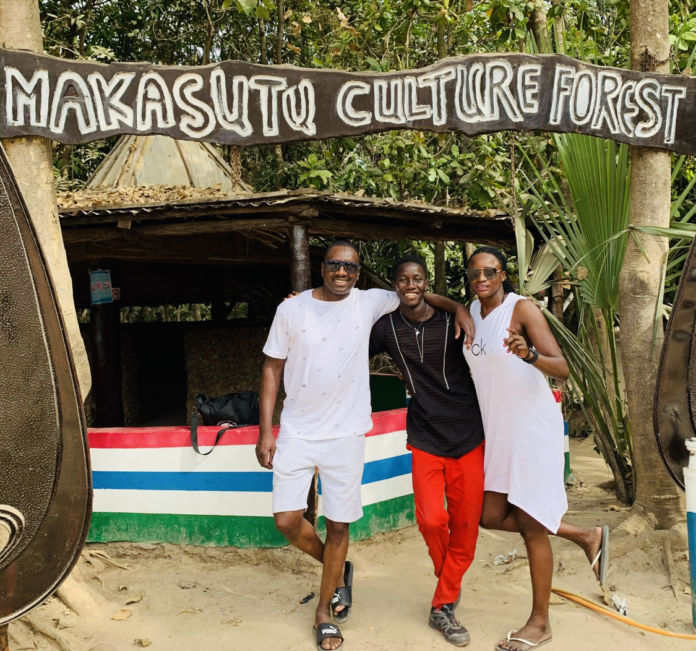By Momodou Ndow
Makasutu is a Mandinka term for a Holy Forest. “Maka” means holy and “Sutu” means forest. I am not sure what prompted my desire to visit Makasutu, but it was sudden. Come to think of it, it was probably because of an urgent need for solitude and rejuvenation after being in The Gambia for a couple of weeks, di dugaaka gaina. Ding, Makasutu came to mind! I’ve heard of the place and seen photos of it before, but out of the blue, suddenly there was this pressing need to go visit the place. So I called my sister, Ida Ndow, and asked her if she has the phone number for Makasutu, since she used to work with Gambia Experience a lot in the past. Moments later, Ida called me back and gave me a phone number designated to a man named Buba Fadera. I called Buba the next day and expressed my yearning to visit Makasutu with my wife for a day trip and asked how to go about it. After a brief conversation, he quoted me a price and said it would include lunch too. I was sold right away and we agreed on a date (02/21), which was just a couple of days away.
After another day of “rang rang”, “peep peep”, and dealing with the traffic officers and their checkpoints, we retired at around 11pm with plans to be up around 8am to get ready for our day at Makasutu. I am surprised Makasutu didn’t show up in my dreams that night, it had been on my mind all day. I slept like a baby though, dama tasson ndaham! The morning was light and we were feeling excited wondering what lies ahead for us at Makasutu. Then around 9am or so, I received a phone call from Buba. He wanted to confirm if our plan to spend the day at Makasutu was still intact and wanted to make sure we had the proper directions to get there. He said it was right outside of Brikama. He also said he was going to meet us there later, but wanted me to call him when we arrive at the gate. An hour later, after putting some necessities together in a bag to take along with us, we were now set to cruise to Makasutu.
The drive there was relatively smooth, since it was on a Thursday morning, and we were going against traffic. Of course, we encountered the police traffic checkpoints along the way, with their usual “hello uncle/sir, lu bakh nak”. And when we reached the checkpoint in Brikama after the UTG campus there, I told the officer that we were heading to Makasutu and asked her how far away we were. She said we were not far away at all and should see the sigh right after the next Gas Station on our left. Like everything Gambia, I was looking out for a giant billboard sign, like the ones with Adama Barrow’s face everywhere, but I missed it and kept driving. I realized it because I saw a sign that read “Serrekundanding”, so I decided to pull over and ask again. I was then told to head back for about half a mile, and the sign should be on my right. And then bingo, there it was, totally different from the “Adama Barrow type billboard” I had in mind. It was a vertical metal sign that spelled out “Makasutu”.
The road to Makasutu from the highway was your typical “off road” track, so it was a good thing that we were driving a Jeep. About a half mile onto the road, we were flagged down by a woman looking for a lift. But because the road led to nowhere else but to Makasutu, I assumed that she too was headed there since there was nothing else around along the way, so I stopped to pick her up. And yes, she was indeed going there. She was one of the Craft Market vendors at Makasutu and was heading to work. Seconds later, a conversation ensured. I asked her how does she normally get to work daily, and she lamented about the transportation hardships and told us that most of the time, she walks to and from work. I am not sure what the distance was, but it’s not short. In any event, I am glad we showed up that day and were able to save her from the runga. Midway through, the conversation shifted to tourism, and again, she lamented about the decline in business due to the dwindling tourist season. Upon arrival, she thanked us for the ride and headed to her business stall area to the right, and we headed straight ahead to the reception area.
As Buba requested from earlier, I called him upon arrival and he asked me to hand the phone over to the lady at the reception, and I believe her name was Amie. After their brief conversation, she looked at us and smiled. She then told us that Buba told her not to collect a dime from me, and that our visit was complimentary. This would normally mean “on the house”, but this time around, it was “on the forest”. As we were being led to the Baobab Cultural Center to be introduced to our tour guide, Lamin Darboe. I was already beginning to feel the Makasutu vibe. Overwhelmed with excitement, I knew it was going to be a fun day ahead. Lamin ushered us into the guest sitting area and sat next to us at the table, as he gave us a rundown of what was ahead for us. We were immediately impressed with Lamin’s confidence and knowledge of Makasutu’s history, so when he mentioned that he was only 18 years of age and had only interned for a few months prior to getting a part time there, we were even more captivated! He is a resident of Serrekundanding.
It was now time to get things going and our first stop was going to be by the pool area for coffee (Base Camp). With Gambia being famous for its extensive birdlife and home to over 600 species, I found myself lost in the tranquil and uniqueness of Makasutu, and the experience was already starting to get magical with striking birds chirping sounds. While sipping our coffee (not Café Touba) and taking it all in, my wife and I were approached by a couple of ladies who wanted to know where we were from. I told them that we were Gambians but my wife lives in London and I live in San Francisco. Then all of a sudden their jaws dropped, and one of them screamed “I am from San Francisco too!” We had a big laugh about the wild coincidence and chit chatted for a bit. As the saying goes, what a small world! We later found our way on top of the tower while Lamin waited for us, to get a full bird’s eye view of the forest, since flying over was not an option kai. There, we were able to take it at 360 degrees and it was a spectacularly beautiful view too.
While we were up on the tower enjoying the 360 bird’s eye view, Lamin was patiently waiting for us down below where Makasutu’s in-house Jaliba, Omar Kuyateh, was singing some tunes for guests lounging around sipping tea or coffee. Upon our return, Jali was singing the “singkoling koling” song. Hypnotized by the song, I had to bust some moves, and my wife quickly joined in. After our impromptu “get down”, Lamin suggested for us to do the nature walk first, since there were a few people ahead of us for the canoe ride, bolong kono. The nature walk was interesting and Lamin has a good knowledge of the environment and educated us about the plants there and all their different medicinal and household uses. For example, the African Mahogany tree is used for digestive problems and for general pain relief. Fortunately, as we were standing under the tree listening to Lamin explain to us how the wild Baboons there peal and chew the stalk of the Mahogany tree when they have stomach issues, a troop showed up and a few of the were doing just that. It was surreal!
Of course, the Mahogany tree is also used for making furniture, and Lamin said husbands used to chop one down to make a bed for their new wife, back in the day. Rek my wife looked at me, y faleh wumakor sah! Lamin is funny, and has a wry way of putting things in his own way. He pointed out a parasitic plant to us, and said he calls it the jealous tree. Parasitic plants are lazy and get all their nutritional requirements from other living plants. They latch onto to the host plant and suck up all the amount of nutrients they require for survival. And, some plants are able to locate their host plants by detecting chemicals in the air or soil given off by a potential host. Talk about a plant with a good nose! According to Lamin, a parasitic plant is jealous because it doesn’t allow other plants around it to exist without sucking them up dry. Besides telling us about the many different plant species at Makasutu, Lamin also told us about the animals and insects there. We saw some enormous termite skyscrapers too. And of course, we got another funny lecture about the life of a termite from him. Part of the nature walk experience was to also visit the in-house Marabout at his hut along the trail, for some herbal remedies from the medicinal trees in the area, as well as settlu (fortune telling).
According to the story, when the two Englishmen, James English and Lawrence Williams were looking to buy a suitable piece of land in The Gambia to create a tourism project, the Marabout, who was living on the land at the time introduced them to the owners of the land, the Sanneh Kunda Family. Part of the story too is that the marabout performed palm reading for James and Lawrence, and prescribed a charity for them. He also told them there will become a time when thousands of people from around the world will come to visit Makasutu. Since part of the plan by James and Lawrence, was to allow the local people that were living and using the land prior to their arrival to stay and possibly incorporate them into the planned tourism project, the marabout was allowed to stay at Makasutu. The Marabout has since died and was succeeded by his eldest son. It was now our turn for palm reading with the marabout as a slice of our nature walk experience, so my wife and I entered the hut. What the marabout told us was fascinating and gave us a sense of peace.
It was now lunch time, so we headed back to the Baobab Cultural Center for a nice Gambian buffet. While we were on our nature walk and ran into the baboons, Lamin had mentioned to us that they know when lunch is and will always show up for their share, and here they were sitting on top of the tables and freely running around the Baobab Cultural Center. They are supposed to be wild, but they sure know how to cozy up to people at lunch time. Right after lunch, a group of Jola drummers and dancers started performing what was their routine performance under the huge baobab tree. They didn’t need to encourage me to join in and dance, I jumped right in and showed them what I was made of. And guess who else jumped in? My wife! After it was all said and done, all the Jola dancers admitted to me that I was a better dancer than them. My “sewruba” skills from Bakau are still with me. Tantang kosso ning dongo layka taa nyola, That was the perfect way to digest lunch, before our next activity, the canoe ride. Then moments later, Buba Fadera arrived and we were able to meet him in person and expressed our profound gratitude for his generosity.
For our canoe ride, we headed back to Base Camp to board from there. We had a different guide for the canoe ride and off we went into the Mandina Bolong, a branch of the River Gambia, for a laid back cruise. While in the canoe, as our rower was navigating through the mangroves, I was busy alternating between attentively listening to our canoe guide and dipping my hand in the water, bolong kono and singing “Bamba woo kanang faa muna Bamba woo, nee bayla yuku yuku la badaator…” Canoeing can be relaxing, and canoeing along the Mandina Bolong was incredibly peaceful too, with the occasional bird calls and the sound of the rower’s paddle as we drifted down the calm waters. On either side, you can see oysters clinging on to the mangroves, which we were told were occasionally collected by local women. After a charming and serene canoe ride, we pulled up and docked at the Base Camp shore and disembarked, as others were waiting for their turn. It was now around 4pm and our day at Makasutu was coming to an end, so we headed for the exit. With the “singkoling koling” song still ringing in our heads, the three of us, Lamin, my wife and I, decided to have our own ‘”singkoling trio”. Aywali yoo borlal yen dannay, aywali yoo borlal yen dannay, singkoling koling sing, singkoling koling sing!! We then hit the Craft Market to pick up a couple of items before beating Lamin goodbye. What a magical day it was!
It was well after our visit to Makasutu that I discovered there was a Mandinka folklore dating back to the 12th century about the forest. It says that a dragon like creature known as “Ningkinangka or Ningkinangko” lives in the swamp, and guards the buried clothes and crown of a tribal king, from the Soninke Kingdom of Busumbala, Mansa Jatta, who was slain in battle by Kombo Sillah, a Muslim king. This was during the period Islam swept into the Senegambia region, from the Sahara. The Ningkinangka is also believed to protect the forest and the nearby community from potential thieves. Legend also has it that the forest was haunted by Jinays (spirits), and as a result, the holy forest was unoccupied, and used mostly for prayer and tribal rituals. They used to bath Njuli yee fofu in the waters of the Madina Bolong as part of the circumcision process. Local kings also prohibited any hunting and cutting down of trees in the Holy Forest. Had I known about this Mandinka Folklore prior to my visit, I would have been singing a different tune bolong kono. Instead, I would have only dipped my fingertips into the water and sang “Ningkinanko kanang faa muna Ningkinanko, nee bayla yuku yuku la bolong kono…”
PS: This piece is dedicated to Lamin Darboe for making our visit educative, fun and memorable.




